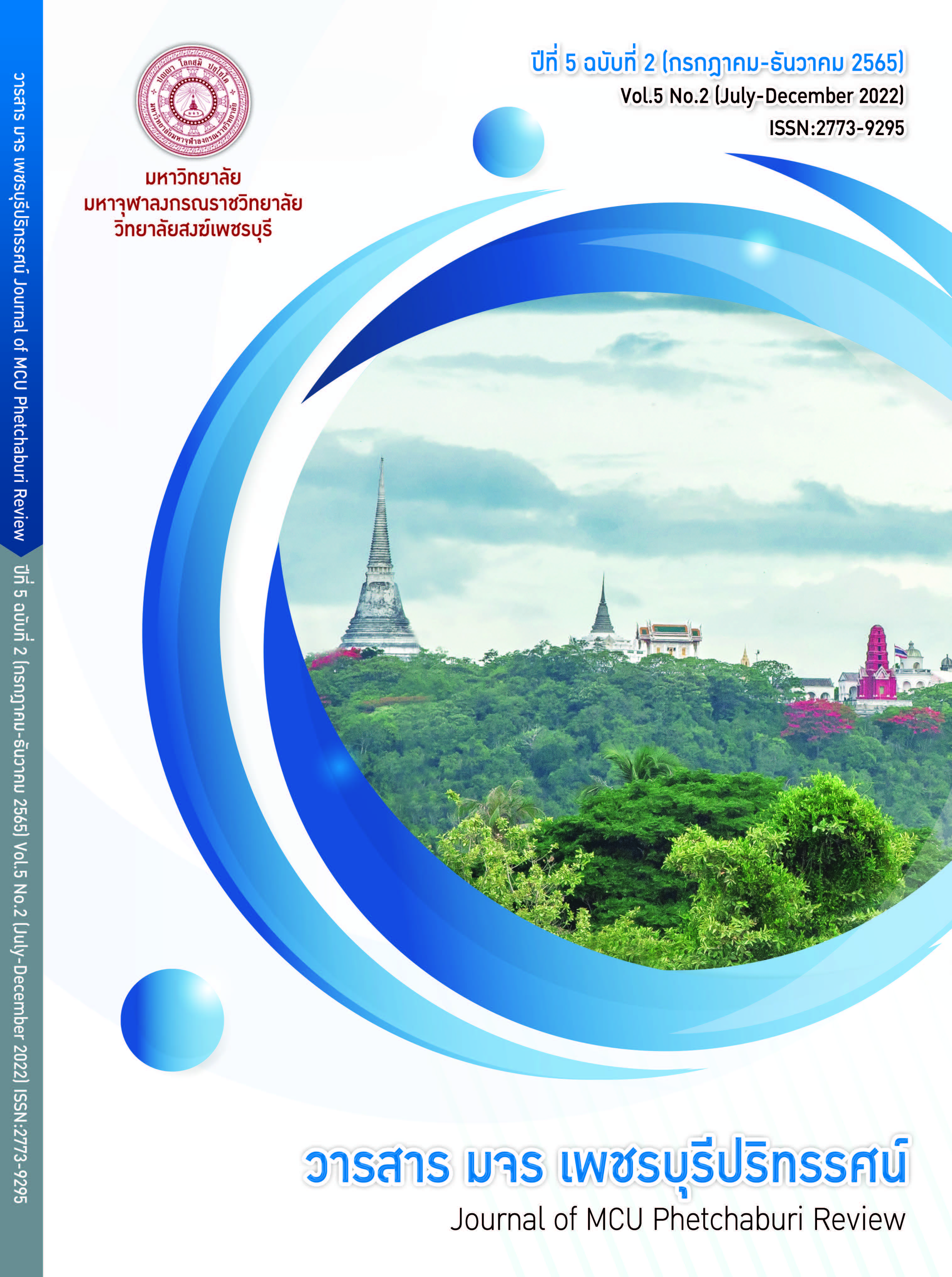PROFESSIONAL LEARNING COMMUNITY TO PROMOTE ANALYTICAL READING AT PADENGVITTAYA SCHOOL THE SECONDARY EDUCATION SERVICE AREA OFFICE PHETCHABURI
Main Article Content
Abstract
In solving the learning management problems in schools, there is an administrative principle able to be used for solving the problems by using the process of creating professional learning community (PLC). The researcher was, therefore, interested in doing the study on creation of PLC to promote analytical reading of Padengwittaya School under the Secondary Educational Service Area Office Phetchaburi with the objectives to: 1) create PLC in the aspect of analytical reading of Padengwittaya School, and 2) develop analytical reading skill of students at Padengwittaya School under the Secondary Educational Service Area Office Phetchaburi. The study target group consisted of 6 teachers and the students in Mathayomsuksa 1-3 (Grade 7-9) at Padengwittaya School. The steps of study were: 1) planning, 2) implementation, and 3) reflection. The research tools were a questionnaire, a test paper, a recording form, an assessment form, a semi-structured interview form, a learning management plan, and focus group discussion. The data were analyzed by using percentage, mean, standard deviation, and t-test.
The research results were as follows:
- The creation of PLC in analytical reading at Padengwittaya School consisted of three stages: 1] Planning stage: organizing according to three components of creating PLC as follows: 1) mutual support and leadership aspect by teachers jointly analyzing, synthesizing concepts and theories of creating PLC, 2) value and shared vision building aspect by teachers attending the meeting to assess and prioritize problems and needs on analytical reading, and 3) favorable condition arrangement aspect by setting up 3 professional learning teams (PLT), 2 people each (buddy) at PADENG PLC Zone, 2] Implementation stage: following the process of creating PLC in the aspects of collaborative learning and application of knowledge by allowing PLT members to participate in observation of teaching and learning, consisting of 1) model teachers, the main teachers teaching Thai language courses, 2) co-learning teachers, 3) learning area leaders, 4) administrators, and 5) specialists, and the final stage, 3] Reflection stage: sharing experiences in solving learning management problems in classroom.
- The results of developing analytical reading skill of students in Mathayomsuksa 1-3 at Pa Deng Wittaya School under Secondary Educational Service Area Office Phetchaburi using a test consisting of comparative skill, classification skill, sorting skill, link skill, and proof skill, revealed that the average score in all aspects and classified by aspects were different with statistical significance at the .01 level.
Article Details

This work is licensed under a Creative Commons Attribution-NonCommercial-NoDerivatives 4.0 International License.
References
กรมวิชาการ. (2551). แนวทางการวัดและประเมินการเรียนตามหลักสูตรการศึกษาขั้นพื้นฐาน
พุทธศักราช 2544. กรุงเทพฯ: คุรุสภาลาดพร้าว.
____________. (2546). พระราชบัญญัติการศึกษาแห่งชาติ พ.ศ. 2542. กรุงเทพฯ: สปอร์ตซินดิเคท.
กานต์ชนก ด้วงตะกั่ว. (2557). การศึกษาความสามารถในการอ่านเชิงวิเคราะห์หน่วยการเรียนรู้วรรณคดี
และวรรณกรรมของนักเรียนชั้นมัธยมศึกษาปีที่ 4 จากการใช้วิธีสอนแบบ SQ4R ร่วมกับแผนผัง
ความคิด. วิทยานิพนธ์ครุศาสตรมหาบัณฑิต สาขาวิชาหลักสูตรและการสอน มหาวิทยาลัยราชภัฏ
นครราชสีมา
การุณันทน์ รัตนแสนวงษ์. (2550). ทักษะการใช้ภาษาไทยเพื่อการสื่อสาร. กรุงเทพฯ : มหาวิทยาลัยศรีปทุม.
เกรียงศักดิ์ เจริญวงศ์ศักดิ์. (2553). การคิดเชิงวิเคราะห์. (พิมพ์ครั้งที่ 4). กรุงเทพฯ : บริษัท ซัคเซสมีเดีย
จำกัด.
จรรยา ศรีบัวหลวง. (2559). การศึกษาความสามารถในการอ่านเชิงวิเคราะห์ ของนักเรียนชั้นมัธยมศึกษาปี
ที่ 2 จากการจัดการเรียนรู้แบบ SQ4R ร่วมกับแผนผังความคิด. การประชุมวิชาการและเสนอ
ผลงานวิจัยระดับชาติ ครั้งที่ 3 ก้าวสู่ทศวรรษที่ 2: บูรณาการงานวิจัย ใช้องค์ความรู้ สู่ความยั่งยืน”
มิถุนายน 2559 ณ วิทยาลัยนครราชสีมา อำเภอเมือง จังหวัดนครราชสีมา.
ชนาธิป พรกุล. (2555). การออกแบบการสอน: การบูรณาการ การอ่าน การคิดวิเคราะห์และการเขียน.
พิมพ์ครั้งที่ 3. กรุงเทพฯ: สำนักพิมพ์แห่งจุฬาลงกรณ์มหาวิทยาลัย.
ชูชาติ พ่วงสมจิตร์. (2560). ชุมชนการเรียนรู้ทางวิชาชีพและแนวทางการนำมาใช้ในสถานศึกษา.วารสาร
ศึกษาศาสตร์ มหาวิทยาลัยสุโขทัยธรรมาธิราช, 10 : 34-41
ฐะปะนีย์ นาครทรรพ. (2545). การสอนภาษาไทย. กรุงเทพฯ : ศูนยสงเสริมวิชาการ.
ทิศนา แขมมณี. (2557). ศาสตร์การสอน : องค์ความรู้เพื่อการจัดกระบวนการเรียนรู้ที่มีประสิทธิภาพ.
กรุงเทพฯ : สำนักพิมพ์แห่งจุฬาลงกรณ์มหาวิทยาลัย.
ประพันธ์ศิริ สุเสารัจ. (2551). การพัฒนาทักษะการคิด. กรุงเทพฯ : 9119 เทคนิคพริ้นติ้ง.
ประเวศ วะสี. (2547). การบริหารจัดการภาครัฐแนวใหม่. กรุงเทพฯ: จุฬาลงกรณ์มหาวิทยาลัย.
วรรณี โสมประยูร. (2553). การสอนภาษาไทยในระดับประถมศึกษา. กรุงเทพฯ : พิมพ์ลักษณ์.
สถาบันส่งเสริมการสอนวิทยาศาสตร์และเทคโนโลยี. (2563). เอกสารประกอบการอบรม การจัดการ
เรียนรุ้ฐานสมรรถนะทางคณิตศาสตร์ โครงการเพิ่มศักยภาพครูให้มีสมรรถนะของครูยุคใหม่ สำหรับการเรียนรู้ศตวรรษที่ 21. กรุงเทพฯ: ผู้แต่ง.
สำนักงานคณะกรรมการการศึกษาขั้นพื้นฐาน. (2560). คู่มือประกอบการอบรม การขับเคลื่อน
กระบวนการ PLC (Professional Learning Community) “ชุมชนการเรียนรู้ทางวิชาชีพ” สู่
สถานศึกษา. สืบค้น 10 กันยายน 2564
สุภาวดี ปกครอง. (2561). การพัฒนาครูโดยใช้แนวคิดชุมชนการเรียนรู้ทางวิชาชีพ เพื่อการอ่านออกเขียน
ได้ของนักเรียนประถมศึกษา. วารสารสุทธิปริทัศน์ปีที่ 32 ฉบับที่ 101.
สุวิทย์ มูลคำ. (2550). กลยุทธ์การสอนคิดวิเคราะห์. (พิมพ์ครั้งที่2). กรุงเทพฯ: ห้างหุ้นส่วนจำกัดภาพพิมพ์.
Dufour, R. (2004) : What is professional learning community. Education Leadership, 61
DuFour, R. (2010). Professional learning communities: A bandwagon, an idea worth
considering, or our best hope for high levels of learning?.Middle School Journal, 39, 4-6.
Eastwood, K. W., & Louis, K. S. (1992). Restructuring that lasts: Managing the
performance dip. Journal of School Leadership, 2(2), 213–224.
Hord, S. (1997). Professional learning communities: Communities of continuous
inquiry and improvement. Austin, TX: Southwest Educational Development Laboratory. Retrieved November 24, 2015, from http://www.sedl.org/pubs/change34/2.html.
Senge, P. M. (1990). The Fifth Discipline: The Art and Practice of the
LearningOrganization.Doubleday, New York, NY: MCB UP Ltd.
Hipp, K. & Huffman, J. (2003). Professional Learning Communities: Assessment-Development-
Effects.Paper presented at the meeting of the International Congress for School Effectiveness andImprovement. Sydney: Australia.(8), 6-11.


